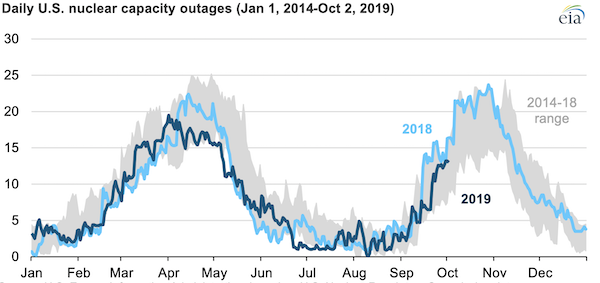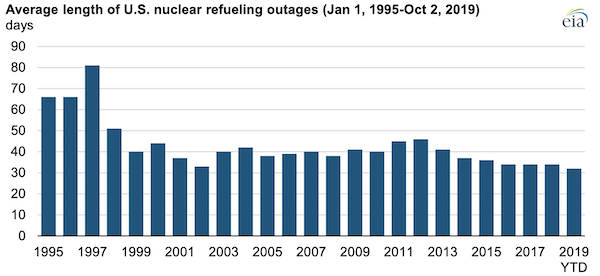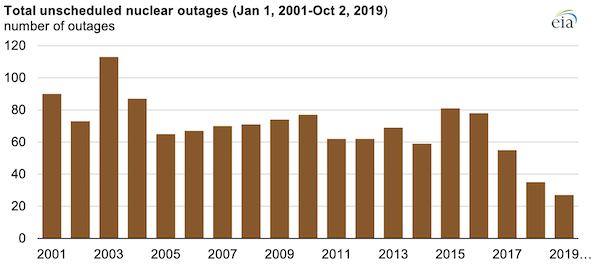U.S. nuclear electric generation plant outages averaged 2.7 gigawatts (GW) during the summer of 2019 (June through August), about the same as during the summer of 2018. Nuclear plant availability was at its highest level, meaning that nuclear outages were at their lowest level from late June to early July, averaging 1.2 GW. Although the Three Mile Island Unit 1 retired in late September, daily nuclear outages that month were 67% lower than year-ago levels. Nuclear plants undergo planned outages, usually for maintenance and refueling, or unplanned outages, such as during hurricane-related disruptions.

Nuclear outages are usually lowest in the United States during summer and winter when electricity demand is relatively high so that plant operators can meet increased cooling and heating demand. Even in the spring and fall, when U.S. electricity consumption is lowest, nuclear outages are typically at their highest, with only about 20% to 25% of U.S. nuclear generating capacity offline at any time.
A planned nuclear generation outage is generally timed to coincide with a plant’s refueling cycle. In the United States, nuclear power plants typically refuel every 18 to 24 months, often during the fall and spring when electricity demand is lower. During a refueling outage, plants typically optimize downtime by scheduling facility upgrades, repairs, and other maintenance work while the reactor is offline.
Average refueling outage times have shortened in recent years, decreasing from an average of 46 days in 2012 to 32 days in 2019. So far in 2019, five reactors required refueling times of 20 days or fewer.

Unplanned, or forced, nuclear generation outages can result from equipment failure, operational error, environmental conditions, or external circumstances. Most unplanned outages are not related to the nuclear reactor core. For example, severe weather or non-nuclear internal plant conditions may affect steam turbine and electricity generation sub-systems.
Early reactor retirements also factor into unplanned outages, which affected available summer capacity in 2019. The Pilgrim Unit 1 in Plymouth, Massachusetts, retired in May 2019, removing 678 megawatts (MW) of available net summer nuclear capacity. On September 20, the single remaining unit of the Three Mile Island plant retired, removing another 803 MW of nuclear generating capacity.
The number of unplanned U.S. nuclear generation outages has fallen for the past three years, most recently totaling 35 separate outages in 2018. So far in 2019, the United States has had only 24 unplanned nuclear outages. These outages can fluctuate year to year based on plant technical issues and external circumstances.

EIA expects nuclear outages to continue increasing in the near term as U.S. nuclear plants enter their fall refueling and maintenance season. EIA's Status of Nuclear Outages page, which is based on data collected by the U.S. Nuclear Regulatory Commission, provides more information on the daily operation of U.S. nuclear power plants.
Principal contributor: Slade Johnson









